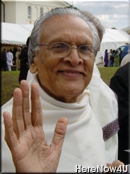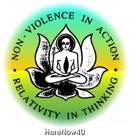

The world is a house of animate and inanimate, of conscious and unconscious. To survive, a partnership between the two is essential. A touch of the animate infuses with life all, that which is inanimate. What is it that allows mind to think, ears to hear, eyes to see, nose to smell, tongue to taste, and body to feel? It is consciousness. Otherwise, our brain and five senses would be unaware, lifeless, and unable to function.
Life is radiating behind all living forms. What can we call that invisible life-giving element? In Sanskrit language, it is known as atma. In English, it has been called soul, spirit, self, the divine. Truly speaking, none of these words carries the full import of atma. When one hears these words, one must get a sense of vibrant living energy. That is why, in this series of talks, I often prefer to use the phrase sentient energy to bring out the inherent dynamism of the words atma, soul, spirit, or self.
Let us clarify the word sentient. Ordinarily, it means one has the power to apperceive by means of the senses; it is also defined as the conscious mind. The meaning I aim to convey is inclusive yet greater than any of the above definitions. Sentient energy is that in each one of us, which is conscious awareness itself. It is our immortal essence, incapable of either stagnation or physical harm, for it is not a material substance. We may call it life, indweller, the one we are from beginningless time. We must know it, express it, and make friends with it.
That is one of the purposes of this series of talks. To know and experience atma as our nearest and dearest one, this is the clear awareness, which must dawn on human consciousness. When we learn to differentiate between soul and matter, we will come into the experience of our conscious reality. In the words of the ancient seers:
No weapon can cut it
Nor any fire burn it.
No water can make it wet
Nor any wind dry it.
It is atma, immortal.
It is indestructible sentient energy.
***
Now we will investigate the two entirely different and unique energies working in this universe, the one conscious, and the other unconscious. In this philosophy, the smallest indivisible form of matter is called atom. Atom means the essential structure of the material world. When atoms come together, they form molecules. When molecules group together, they construct the myriad of bodily forms found in the material universe.
Atom is energy, an insentient or unconscious energy. Its nature is this: that molecules compose and decompose. They are in a perpetual state of flux. They are continually alternating between motion and rest, like the pendulum of a clock. As such, they bump up against one another, thereby creating an impact or a vibration.
Unlike atom, the nature of atma or sentient energy is to be conscious. It has creative power. Its power is this: to change the arrangement of the material world of atoms. Together atma and atom make up the structure of the whole universe.
When we understand the two polarities, the East exploring the secret of atma and the West exploring the secret of atom, our knowledge becomes complete.
If we see only one polarity, our vision tends to become myopic. Those who see nothing beyond atom strive only for material achievement and end up where they began - in the process of construction and destruction of molecules. Seeing man as a machine, they risk their own annihilation. At the same time, those who neglect the study of atom for an exclusive interest in atma risk becoming engulfed by poverty, indifferent towards progress, and callous towards suffering livings beings.
To live we need both, food for the body and nourishment for the soul. We need balance. We need to sit at the centre of ourselves and observe both atma and atom. Watching ourselves with the eye of wisdom, we will see that we are neither biased nor pious, but open and moving - towards the enlargement of heart and the enlightenment of consciousness.
How can we experience that balance? By shedding the spiritual light of the atma on atom. By becoming aware through meditation of both the centre and the circumference. By differentiating between sentient and insentient. Balanced, our movement will be characterized by purposeful direction (pragati) and not by a vicious circle (gati). In this way, our sentient energy will be evolving towards ultimate complete awareness of itself.
By expanding our understanding of the relationship between atma and atom, by being in tune through meditation with the permanent qualities of our self, we can be of service to ourselves and to the entire family of man and all living beings. The expression of our meditative balance in everyday life will come according to our individual nature - to be actively calm or calmly active.
How can we know the difference between sentient and insentient energy? How can we know the relationship between these two? To begin to understand these questions, the real seeker discovers right away that intellectual analysis and logic will not help him. He is aware that the mind is a fine form of matter and cannot see beyond its own self. Mind always dissects and finalizes on a material level.
What the seeker wants is to go beyond that which is tangible or visible. He sees that the world of mind is primarily a business of words and arguments, of discussions and quotations. He observes how mind becomes deluded by words and how it fools itself by presuming, "I am getting an insight into something higher." But instead of gaining insight, it is creating categories. Mind likes to give labels to those who do not agree or believe. It uses names such as 'atheist' or 'pagan' because of its habitual tendency to react and create a form. Mind, which clings to forms, looks upon anyone who goes out of the form or the norm as its foe.
This is how religious people who claim to love harmony bring instead disharmony. This is why wars are still fought in the name of God or land or ideology. Always the world of forms creates some kind of friction; one sees there the collision of minds.
Even the psychic experience is a creation of mind. Though it may be called a spiritual experience and though it may appear in a subtle form, still it is interplay of matter. It is in the kingdom of mind. Mind is still governing, operating, and controlling.
When mind - words, logic, scriptures, arguments, forms - is allowed to rule your life, you do not set yourself free to see and feel the beauty and serenity of that which is beyond mind. The real beauty starts when you begin to get in touch with that. The genuine seeker's journey begins here.
So those who want to go beyond mind take a higher step. Instead of entering into argument, they turn inward. It is not introversion; it is introspection. It is a purifying. You notice what is taking place in your thoughts, in your feelings, in your fancies. Gradually you observe your relationships in intimate commune with yourself.
When you go on watching yourself, your awareness of all your thoughts increases. A light of calmness reaches a point where any negative thought or emotion stands out and is easily recognized. It may be a spark of anger, a flicker of jealousy, a heaviness of greed, a puffing up of ego, a wave of deceitfulness. Upon recognizing them, dopratikram: go back to erase and obliterate the darkness of negativity by working with your breath until the heaviness of the emotion evaporates.
Eventually with vigilance and continued practice of this introspection, a fresh awareness dawns upon you: that now mind is not operating, governing, or controlling. Mind is operated, governed, and controlled. By whom? By sentient energy, by atma, by soul, by that which has the living force of life, a deep awareness of innate qualities.

 Clare Rosenfield
Clare Rosenfield